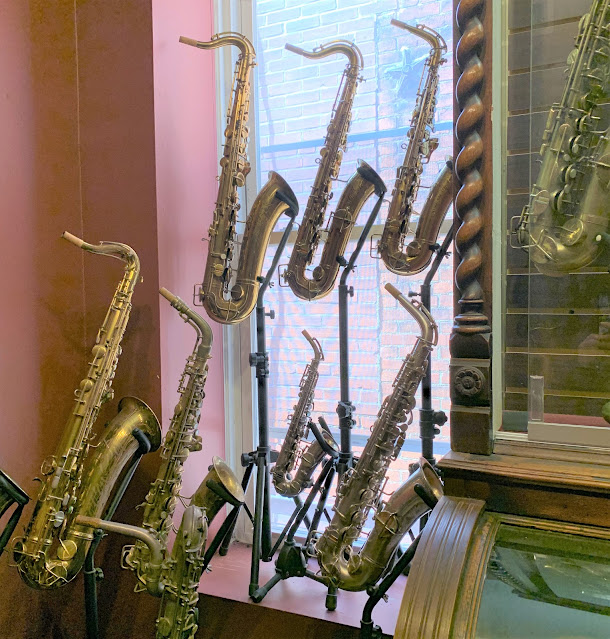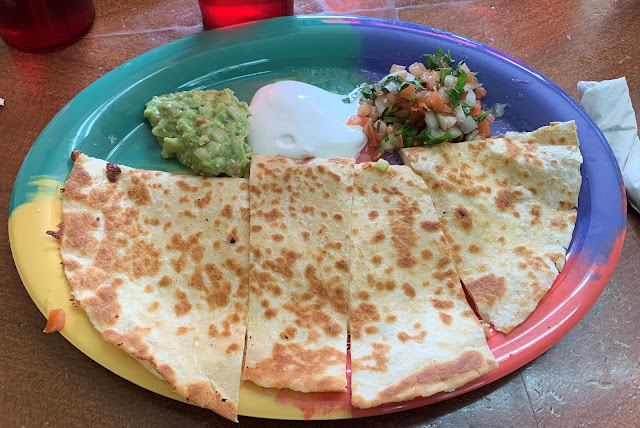Admission is free as is street parking.
https://nationalsaxophonemuseum.com/
Opened in 2007.
The saxophone museum occupies the second floor of the Saxquest store which is on Cherokee Row in St. Louis. Saxquest is one of 6 stores in the United States that deal solely in saxophones. The store owner has a large private collection of about 200 saxophones plus related items that for a number of years were on display in the store. In 2007 the collection was moved upstairs and the Saxquest Museum was born. Last year the second floor became officially the National Saxophone Museum.
The museum has two rooms that are filled with many saxophones lined up next to each other.
The saxophones in this room are among the older ones in the collection. Some even are on display in the windows.
The other room has saxophones that are newer.
The hallway has this case which holds a collection of saxophones made by Adolphe Sax who is credited with being the inventor of saxophones.
Sax, a Belgian musician, lived from 1814-1894. A poster on the wall tells us more about Sax. Among the oldest instruments in the collection are these Rothphones, from the 1800's. They were a double-reed instrument as opposed to the saxophone which has only one reed in the mouthpiece.
These soprano saxophones are in one case.
This group of straight saxophones are in the newer collection.
This is one of the rarest of the saxophones. It has a bulb end like an English horn and was developed for the orchestra. However its sound did not fit well in orchestral pieces and it was basically replaced in the orchestra by the English horn.
This is another special saxophone which did not last long because of the difficulty playing it due to the many keys. This is a VERY LARGE contrabass saxophone.
And here we have a serpent saxophone.
This saxophone is made of plastic instead of the usual brass.
And of course, today, every type of instrument including saxophones have to be able to be electrified!
The museum also displays some saxophone accessories.
And finally there is a case dedicated to Charles Gerard Conn who was a leader in the manufacturing of musical instruments. This display includes his family Bible. The third and final room holds the archives of the museum.
Cherokee Row, home of the museum, is an historic district filled with early 19th century architecture. The six blocks of Cherokee Row are known for their antique and specialty shops and also their restaurants, cafes and bakeries. After visiting the museum we had lunch at Taqueria El Bronco, one of several Mexican restaurants on Cherokee.
We enjoyed the taco salad, the cheese quesadillas, and the luncheon special with tacos. After lunch we crossed the street and walked half of a block to a Mexican bakery.
It was hard to chose what to buy for dessert!
Comments:
This was probably the smallest museum we have been to and was unique in that its displays were limited to just one thing - saxophones! There were so many! You had to look carefully to understand how they differed. Nothing is labeled so a visitor does not have a sense of when the instruments were made or why certain ones were special. Fortunately one of the store employees was able to join us in the museum and explain some of the instruments and displays to us. That was helpful. I'm sure visual labels would have made a big difference in appreciating more of the instruments.
All in all the collection was impressive and when the owner is able to finalize the displays it will be even more appreciated and informative.
The restaurant was casual with a full menu of typical Mexican food. Everyone found their lunch to be excellent. The bakery likewise had great options of sweet Mexican treats. We had to ask the salesgirl what the offerings were before we placed them on the empty trays she handed each of us. My choice turned out to be great!



























No comments:
Post a Comment